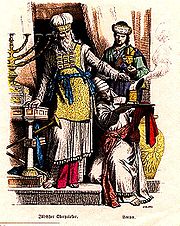
Avnet (kohen)
Encyclopedia

Hebrew Bible
The priestly sash or girdle (Hebrew avnet אַבְנֵט) was part of the ritual garments worn by the Jewish and priestsKohen
A Kohen is the Hebrew word for priest. Jewish Kohens are traditionally believed and halachically required to be of direct patrilineal descent from the Biblical Aaron....
of ancient Israel whenever they served in the Tabernacle
Tabernacle
The Tabernacle , according to the Hebrew Torah/Old Testament, was the portable dwelling place for the divine presence from the time of the Exodus from Egypt through the conquering of the land of Canaan. Built to specifications revealed by God to Moses at Mount Sinai, it accompanied the Israelites...
or the Temple in Jerusalem
Temple in Jerusalem
The Temple in Jerusalem or Holy Temple , refers to one of a series of structures which were historically located on the Temple Mount in the Old City of Jerusalem, the current site of the Dome of the Rock. Historically, these successive temples stood at this location and functioned as the centre of...
.
The "sash" or "girdle" worn by the High Priest was of fine linen with "embroidered work
Embroidery
Embroidery is the art or handicraft of decorating fabric or other materials with needle and thread or yarn. Embroidery may also incorporate other materials such as metal strips, pearls, beads, quills, and sequins....
" in blue, purple and scarlet ; those worn by the priests were of white, twined linen. The sash should not be confused with the embroidered belt of the ephod
Ephod
An ephod was an article of clothing, and a worship object, in ancient Israelite culture, and was closely connected with oracular practices....
. Like the other priestly vestments, the purpose of the sash was "for glory and for beauty" . On the Day of Atonement
Day of Atonement
Day of Atonement may refer to:*Yom Kippur, the Jewish Day of Atonement* Day of Atonement , a national day established in 1995 by the Nation of Islam...
the High Priest changed into special linen garments that included a sash of fine linen without any embroidery . These linen garments were worn only once, with new ones being made each year.
Rabbinical commentary
According to Rabbinical literature, MidrashMidrash
The Hebrew term Midrash is a homiletic method of biblical exegesis. The term also refers to the whole compilation of homiletic teachings on the Bible....
and Maimonides
Maimonides
Moses ben-Maimon, called Maimonides and also known as Mūsā ibn Maymūn in Arabic, or Rambam , was a preeminent medieval Jewish philosopher and one of the greatest Torah scholars and physicians of the Middle Ages...
, the sash was 32 cubit
Cubit
The cubit is a traditional unit of length, based on the length of the forearm. Cubits of various lengths were employed in many parts of the world in Antiquity, in the Middle Ages and into Early Modern Times....
s long and 2, 3 or 4 fingers wide. At this length, it would have to have been wound around the body several times. Theories differ as to how this was accomplished: some say it was wound around the waist only, while others say it was wound around the waist and over the shoulders, crossing over the heart. In any event, the ends would have been tied and allowed to hang down in front. According to the Talmud
Talmud
The Talmud is a central text of mainstream Judaism. It takes the form of a record of rabbinic discussions pertaining to Jewish law, ethics, philosophy, customs and history....
, the wearing of the sash atoned for "sin
Sin
In religion, sin is the violation or deviation of an eternal divine law or standard. The term sin may also refer to the state of having committed such a violation. Christians believe the moral code of conduct is decreed by God In religion, sin (also called peccancy) is the violation or deviation...
s of the heart" (impure thoughts) on the part of the Children of Israel (B.Zevachim 88b).
See also
- MichnasayimMichnasayimThe priestly undergarments were "linen breeches" worn by the priests and the High Priest in ancient Israel. They reached from the waist to the knees and so were not visible, being entirely hidden by the priestly tunic.-Hebrew Bible:...
- Priestly tunic
- MitznefetMitznefetThe priestly mitre or turban was the head covering worn by the Jewish High Priest when he served in the Tabernacle and the Temple in Jerusalem.-Etymology:...
- Priestly robe (Judaism)
- EphodEphodAn ephod was an article of clothing, and a worship object, in ancient Israelite culture, and was closely connected with oracular practices....
- Priestly breastplate
- TzitzTzitzThe priestly crown or frontlet was the golden plate or tiara worn by the Jewish High Priest on his mitre or turban whenever he would minister in the Tabernacle or the Temple in Jerusalem.-Etymology:...

